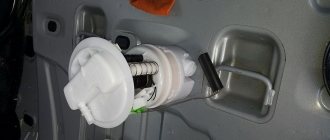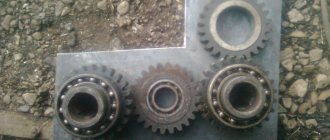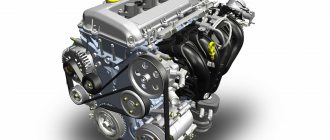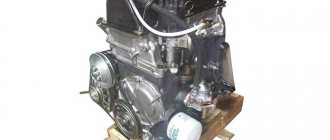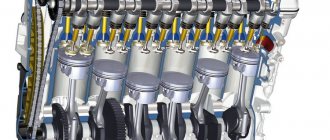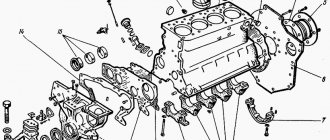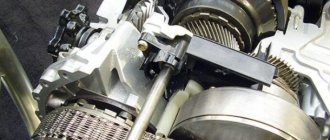February 17, 2015 Lada.Online 418 206 31
Depending on the year of manufacture, the Largus may be equipped with a Renault or VAZ engine. Currently, only domestic engines are installed on this car. Let's take a closer look at the technical characteristics of Lada Largus engines, as well as the features of their assembly.
- Renault-Nissan K7M
(8 valves) with a volume of 1.6 liters is capable of developing a power of 84 hp. This motor is installed on the “standard” and “norm” configurations. - Renault-Nissan K4M
(16 valves) is slightly more powerful, also 1.6 liters, but has a power of 105 hp. or 77 kW. The motor is provided for the “luxury” configuration. - VAZ 11189
(1.6 liter, 87 hp, 8 valves) began to be installed instead of K7M in 2015. - VAZ 21129
(1.6 liter, 106 hp, 16 valves) began to be installed instead of Renault K4M in October 2021. - VAZ 11182
(1.6l., 90hp, 8kl) began to be installed on Largus FL from March 2021
Both are Renault Alliance engines. Since December 2015, AVTOVAZ began installing its 8-valve VAZ-11189 engine. You can get acquainted with its pros and cons from this review.
Both engines from Renault-Nissan are paired with a 5-speed manual transmission. At the moment, AVTOVAZ does not plan to equip the Lada Largus with an automatic transmission.
Lada Largus engines are distinguished by high elasticity, and the manual gearbox is distinguished by precise gear shifting. For dynamic acceleration and confident overtaking, the engine power is quite enough. Both Lada Largus engines comply with Euro 4 environmental requirements.
Depending on the vehicle configuration, there are several options for installing auxiliary equipment on the engine:
- car with non-power steering;
- car without power steering with air conditioning;
- vehicle with hydraulic power steering;
- car with hydraulic power steering and air conditioning.
Content
- Who is the seven-seater cabin suitable for?
- Are there any differences in the configurations?
- What engines are on the Lada Largus?
- How does the Cross version differ from the regular one?
- What problems might you encounter?
- What to look for when choosing a Lada Largus
- Which Largus to choose
LADA Largus is one of the most affordable station wagons on the Russian market. On the secondary market it is sold on average for 461 thousand rubles.
The model went on sale in 2012 and has never been updated since then. You can choose from 5- or 7-seater body styles, a van or a Largus Cross raised by 25 mm.
Until 2021, Largus was sold with French engines, and after they were replaced by Russian engines of the same displacement. We'll look into this article about which Largus is better and which modification to choose on the used market.
Engines for Largus
The body is a body, but the car must be driven by something. The manufacturer did not reinvent the wheel and installed engines from Logan on Largus:
- K7M with 8 valves - 86 hp;
- K4M with 16 valves - 105 hp.
But, there is a domestic development, the engine from Vesta - VAZ 11189. It is also installed on Largus. In fact, this is an engine from Granta, only converted to Euro 5 standards.
We are interested in the last 2 engines: the French one with 16 valves and ours with 8 valves. It’s interesting to know what reviews car enthusiasts write about Largus with a VAZ engine. And of course, compare them with reviews of a foreign-made 16-valve engine.
There is enough information on the network for both engine models. Reviews are also welcome. Experienced owners of Largus are ready to share their opinions and for this you do not need to go through a lot of sites on the Internet. Everything interesting is collected below.
Who is the seven-seater cabin suitable for?
The third row of seats is useful not only for large families. The seven-seater modification is suitable for both travel enthusiasts and taxi companies. The third row of the Largus is spacious. Not only children, but also short adult passengers will fit there. Rear passengers will have not only seats and seat belts, but also windows and even cup holders.
The trunk of the Largus in a five-seater version holds 560 liters, and if you use all seven seats, then there will be another 135 liters left in the trunk to accommodate a couple of backpacks. But if you fold all the seats, the space increases to 2,350 liters!
Cars with the capacity of a minivan are a rarity on the Russian market, and in the segment up to 400 thousand rubles, only one option is available - the Lada Largus.
Also read: Not everything is so bad: pros and cons of LADA Largus
Which engines are better? VAZ or Renault?
Domestic engines are superior to their French predecessors. Cars with VAZ engines accelerate faster, pull better at low speeds, are quieter and have lower fuel consumption.
Both domestic engines installed on the Lada Largus are modifications of older models. They have already stood the test of time and proven their competitiveness. Thanks to the reduction in the cost of engines, AvtoVAZ added to the car's equipment - athermal glass was added, an improved vacuum brake booster, the windshield wiper mechanism was changed, additional sensors appeared, etc. The car became more comfortable, but the price remained the same.
VAZ 11189 and 21129 have an important advantage. Spare parts for them are cheaper than for French engines. All internal combustion engines installed on Largus require careful maintenance and monitoring, but driving a car with a domestic engine is cheaper.
To make the price of spare parts and service even cheaper, order them from Largus Shop with free delivery. We regularly hold promotions and give discounts to regular customers.
Source
Are there any differences in the configurations?
The basic Largus package includes central locking with an immobilizer, one airbag for the driver, manual windows, ISOFIX mounts, mud flaps on the front wheels and “stamping”. Standard equipment adds foglights, heated front seats and another airbag for the passenger.
Largus has many configurations, but they differ only slightly. For example, the only difference between the luxury version and the standard version is the air conditioning. The difference between luxury and standard in the cross version is only in the wheels - casting instead of stamping.
Also read: Berry again? Review of Lada Kalina II
Reviews
Alexander Tatishchev, Yaroslavl, Comparison of Kalina and Largus with a 16-valve engine
I was lucky to be the owner of 2 cars of our production: Kalina 2 with an 8-valve engine and Largus with a new 16-valve engine. Well, like new - borrowed. Therefore, for fun, I decided to compare the 16 valve engine and the Largus with the VAZ engine and write a review about my feelings.
For your information! Kalina is also equipped with a VAZ 11189 engine with 8 valves.
I often drive Kalina fully loaded, since my professional occupation is construction. It happens that she has to carry half a ton. Well, Kalina on the 11189 engine with 8 valves is quite playful. Even when climbing, it is easy to overtake. Our engineers built an excellent 8 valve engine, in my opinion.
Largus will have a greater carrying capacity, but the weight of the car will also be greater. I even did a little tuning, but it doesn't help. The car does not drive stupidly, there is no agility even when empty. Therefore, the K4M engine in the Lada Largus with 16 valves does not deserve the most flattering reviews.
I'm seriously thinking about changing Largus to another car. You can even use Kalina, only newer.
Ivan Kulba, Lada Kalina 2 with VAZ 11189 engine, Nizhny Novgorod
For the last 2 years I have been driving Kalina 2. I live in a rural area, so I carry a lot of cargo, both domestic and for work. In general, the car is always loaded. I did not experience any problems during operation. From time to time it was necessary to adjust the valves at a company service center. Well, standard maintenance. I have driven 20 thousand in 2 years. I know that even if 11189 with 8 valves breaks down, its repair will not be expensive. I use semi-synthetic oil. My neighbor has a Lada Largus with a VAZ 11189 engine and his reviews are not so flattering. Once he let me drive in his empty car. Largus has no dynamics at all. I don’t even know how people tolerate such a dull throttle response. Perhaps the reworking of the engine to the Euro 5 standard had an effect, but the car should not lose so much in dynamics. It’s good that the amount of repairs, if anything, will be the same. But what about the 16 valve Largus? Repairs there will cost a pretty penny.
For your information! Simplicity of design is the main distinguishing feature of the VAZ 11189 engine, compared to a foreign-made 16-valve engine. If the latter breaks down, repairs will be significantly more expensive. True, the French engine is more modern than ours.
Nikolay the Last, Lada Largus 1.6 (105 hp) 2014, Ulyanovsk
In principle, the car is not bad, quite roomy. But there is one unpleasant feature. It’s as if the designers were in cahoots with the oil workers, or the engineers don’t know how to do calculations! The fact is that fuel consumption is 6 liters. 100 km outside the city can only be achieved at a speed of 60 km/h. But will there be anyone willing to plod along at such a snail’s pace? We have damaged roads, but not to the same extent. This car should have such consumption only at 90 km/h. Although the manufacturer claims that the 16-valve engine is economical, this does not turn out to be the case in practice. I don’t know what kind of engine chip tuning the Lada Largus needs to get a positive review. And the dynamics – it’s as if they don’t exist. When the air conditioning is turned on in the summer, the already slow car still loses its dynamics. As for the standard speed of 90 km/h, the engine has 8.5 liters per hundred. No good!
What engines are on the Lada Largus?
The Largus is equipped with a 1.6-liter engine, which, on the one hand, has established itself as a relatively reliable unit. On the other hand, due to the maximum economy with which it was created, it requires a lot of attention and maintenance. The motors are not quiet and smooth and, despite the same volume, operate differently. We'll tell you which Largus engine is better.
Until 2012, Largus were equipped with engines from Logan: 1.6 liters with a power of 84 or 102 hp. With. With timely replacement of spark plugs, oil with filters and timing belt, French engines run up to 150 thousand km. The belt lasts up to 120 thousand km, and replacing it costs about 4 thousand rubles.
Modern Largus are equipped with Russian 8- or 16-valve engines with a volume of 1.6 liters and a power of 87 or 106 horses. In these engines, special attention should be paid to the condition of the timing belt, which lasts up to 60 thousand km. If it breaks, the valve will bend. In addition, the hydraulic compensators that regulate the valves are not provided in the engine, so this will have to be done at a service center at least every 30 thousand km.
Also, Russian engines have problems with throttle valve failure and frequent failure of certain sensors. In terms of noise and vibration levels, domestic engines are also inferior to French ones.
With foreign engines, French gearboxes were installed in Largus. A five-speed manual transmission lasts up to 200 thousand km, and the clutch lasts about as long as the gearbox itself. A new one will cost 4.5 thousand rubles, and the cost of the box itself starts from 70 thousand rubles. Automatic transmission has never been installed on Largus.
Also read: Review of used Lada Priora: is it worth buying
VAZ engines
Both engines (VAZ 11189 and 21129) differ from their French predecessors in increased power, better traction at low speeds and reduced fuel consumption. Just like K7M and K4M, VAZ engines bend valves when the timing belt breaks. According to the regulations, the belt should be changed every 180 thousand km, but Lada Largus owners advise visiting a service every 60 thousand km.
More details about VAZ 11189 (8 valves)
The VAZ 11189 engine has 87 horsepower (K7M has 83 HP) and a maximum torque of 140 Nm (K7M has 124 Nm). It is a modified version of engine 11186 to meet Euro-4 standards.
In comparison with the French analogue, it has better traction at low speeds, maintains dynamics even under heavy load and runs “quieter”. This is achieved due to a lightweight connecting rod and piston group.
Strengths:
- Reduced fuel consumption – 9.1 l/km in the city (instead of 12.3 l/km).
- Better dynamics during acceleration and traction at low speeds.
- It is quieter than its predecessor from Renault.
- Relatively inexpensive spare parts.
The engine runs on AI-92 and AI-95 gasoline. But car owners note that it is better to refuel the 95th. Driving on 92 gasoline increases fuel consumption and reduces acceleration dynamics.
Common problems with ICE 11189:
- The revolutions are floating. Usually the problem is explained by a sensor failure; first of all, you need to check the E-gas electronic throttle actuator.
- Troit. Due to malfunctions in the ignition system, the engine may start to stall. If everything is in order with the ignition system, then you need to check the valves.
- Overheat. The VAZ 11189 has a very unreliable thermostat.
Most problems are explained by the refusal of scheduled maintenance. With timely maintenance and checking of sensors, the ICE 11189 operates stably and shows excellent results.
More details about VAZ 21129 (16 valves)
ICE 21129 – adaptation of the 21127 engine to Euro-5 standards. It was created for the Lada Vesta and X-ray models and has already stood the test of time.
Strengths:
- Reduced fuel consumption – 9.5 l/km in the city (instead of 11.7 l/km).
- Improved dynamics during acceleration.
- Quiet operation.
Engine 21129, like 11189, can run on AI-92. But it is recommended to fill in 95 gasoline. At 92, fuel consumption increases and dynamics deteriorate.
Common problems with internal combustion engine 21129:
- Overheat. The engine does not have the most reliable thermostat.
- Troit. The engine may stall due to faulty spark plugs, coils or clogged injectors.
- Knock under the hood. On some cars, hydraulic compensators make noise; they can be replaced at the dealer under warranty.
In the technical documentation for the car, the timing belt life is indicated as 180 thousand km. But it is better to change it every 60 thousand km. Even if the belt serves the specified period, which often does not happen, the idler pulley and water pump may jam. And if the timing belt 21129 breaks, the valve bends.
How does the Cross version differ from the regular one?
The prefix “cross” to a model name almost always means an artificially created illusion of a crossover. In the case of the Largus, these are unpainted bumpers and plastic linings on the arches and sills, so as not to scratch the most vulnerable parts of the body on dirt roads. The regular Largus is equipped with 15-inch wheels, while the Largus Cross is equipped with 16-inch wheels. The ground clearance of the cross version is 210 mm, while on the regular Largus it is 185 mm.
Car interiors are almost no different from each other. In the cross version, the seats are decorated with oblique stitching, and the dashboard is made of two colors.
For the cross version, the engineers even changed the suspension slightly: the shock absorber body and rear springs are longer. This allows you to feel more comfortable when driving on bad roads than on a regular Largus.
At the same time, Largus Cross spends 1.5 liters of gasoline more than a regular station wagon: 11.5 liters versus 10 liters per 100 km!
Also read: Rare Ladas on the secondary market
Just the facts (compression ratio, technical specifications)
Renault's 16-valve petrol engine comes in several versions. The last of them, the most modern, meets Euro-5 standards. The interesting thing here is that the compression ratio of the Renault 16-valve engine is 9.8. Remember this number? And now - look: for the 8-valve VAZ engine this figure is 10.5!
All internal combustion engines VAZ, January 2016
It turns out that the VAZ engine needs higher quality gasoline, since its compression ratio is higher.
Both engines in question are produced by the VAZ plant. And they both comply with Euro 5 standards. Their working volume is also the same, 1.6 liters. And the number of valves differs:
By the way, engine 11189 looks better than its “predecessor”: it was Euro-4 - it became Euro-5, it had 84 “power” - it became 87! Only the compression ratio of the K7M engine was 9.5. He was an "omnivore".
What problems might you encounter?
The Largus suspension can hardly be called comfortable, but it is reliable. In seven-seater versions and vans, ball joints quickly fail due to the high load on the rear axle. The cost of a new spare part is from 1,000 rubles. Shock absorbers last up to 100 thousand km, but wheel bearings and CV joint boots last no more than 30 thousand km. Original brake pads last up to 40 thousand km, brake discs - up to 50 thousand km, so we recommend changing them at the same time.
Electronics are another weak point of the Lada Largus. When the contacts oxidize, the instrument panel malfunctions and displays unreliable information. And when several diodes in the generator bridge burn out, the battery stops charging altogether.
Rust is a friend of the LADA Largus, which goes hand in hand with it almost from the factory. First of all, doorways and sills are affected, then the engine compartment, hood and bumper. The reason for rapid corrosion is the poor quality of the paintwork.
Also read: How to sell Lada profitably
Main prospects for the development of the Russian Lada Largus project
In the form in which it is now, the Largus project will not be able to exist. We'll have to work hard to maintain the model's potential popularity. And the main efforts will be in updating the design, changing power units to decent options, which is important, and also in decoupling the cost of the car from the foreign exchange rate. There are many options for further actions by the company that will help completely change the fate of the currently not entirely successful model. Among the most popular proposed steps, the following solutions are quite adequate for the company:
- development of a new line of engines that would meet the requirements of environmental friendliness and power;
- purchasing the design of a new generation Renault Logan car or carrying out a facelift;
- replacement of all imported components of the car, of which there are too many in the design today;
- complete change of interior design features, improvement of driver ergonomics and ride comfort;
- work on the practicality of the car, changing the suspension, which today causes a lot of discomfort to rear passengers;
- increasing the vehicle's carrying capacity for use as a cargo van with two passenger seats;
- addition of complete sets with more comprehensive technologies for comfort and ride quality.
It should be noted that most of the proposals come from customer reviews about Largus. Many people condescendingly say that this is a quite good invention of the Russian automobile concern. Others claim that there was no point in inheriting Renault Logan if Largus was actually made objectively worse. In terms of cost, a car today in the cheapest configuration in the form of a 5-seater station wagon costs 500,000 rubles, which in no way explains the meaning of the Russian production of the car. Many questions have accumulated for the domestic manufacturer, and these questions need to be given a worthy answer. We invite you to watch a review of the Lada Largus Cross:
What to look for when choosing a Lada Largus
The model appeared on the market seven years ago, so finding a copy with one or two owners is quite possible (every second Largus, according to statistics from avtocod.ru). If there were more owners, it is unlikely that the car was looked after carefully.
Every third station wagon is sold broken or with unpaid fines, every sixth is on lease or has traffic police restrictions. “Largus” are also seen in passenger transportation; in the secondary market this is a third of all cars sold. The same amount is sold in the pledge. We were “lucky” to run into just such specimens.
The first is the “regular” Largus 2015. with mileage 125 thousand km:
The car was issued a duplicate title, and most likely it is a credit car.
The report showed one accident that occurred in 2015, and calculations were made in 2021. The repairs were carried out based on one problem, and their total amount exceeded 744 thousand rubles. Many parts were replaced. Apparently the car was in a serious accident.
The second lien Largus was given in the Cross version. 2021, 14 thousand km, 1 owner, 6 months of operation:
The check did not reveal any other problems other than the deposit:
But even with this problem, it is risky to rent a car. All encumbrances after the purchase will fall on the new owner.
Also read: All Russian cars are bad: truth or stereotype
Engines Lada Largus 1.6 liter 16 valves
In the first years of production, the top-end unit of the model was the 16-valve Renault K4M engine. This is a classic old-school internal combustion engine with distributed fuel injection, a cast-iron block, a 16-valve cylinder head with hydraulic compensators and a timing belt that bends the valves if it breaks. Its main problems are electrical failures, oil and antifreeze leaks, as well as floating speed due to contamination of the throttle assembly or fuel injectors. This engine was coupled with a Renault JR5 5-speed manual gearbox.
At the end of 2021, the 16-valve K4M replaced a similar domestic unit VAZ 21129. It is very similar in design: with distributed fuel injection, a cast iron block, an aluminum 16-valve cylinder head with hydraulic compensators and a timing belt drive. Like all Largus engines, this one is distinguished by a long service life and the absence of serious problems: often the only concern is the failure of sensors and attachments, but spare parts are inexpensive. Until 2021, when plugless pistons appeared, the valves in it were bent when the belt broke. At first, the engine was combined with a 5-speed Renault JR5, and in 2018 it was replaced by a VAZ 21809 manual transmission.
Source
